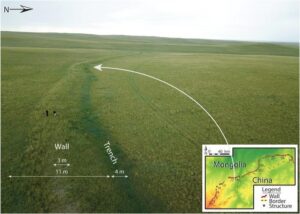
The “Mongolian Arc,” spanning 405 kilometers in eastern Mongolia, comprises an earthen wall, a trench, and 34 accompanying structures. Constructed between the 11th and 13th centuries A.D., this intricate system has emerged as a pivotal yet understudied facet of historical architectural marvels.
The research, conducted through a collaborative effort, involved a comprehensive approach combining remote sensing data collection, archaeological field surveys, and analysis through geographic information systems (GIS). Professors Shelach-Lavi and Amartuvshin’s team also delved into ancient written sources to offer a preliminary interpretation of the design and potential functions of the Mongolian Arc.
“Understanding the significance of the Mongolian Arc unlocks profound insights into medieval wall systems, raising pertinent questions about the motives, functionality, and enduring consequences of such colossal constructions,” remarked Prof. Gideon Shelach-Lavi.
This study is part of a larger multidisciplinary project, funded by a generous research fund from the European Research Council (ERC) addressing the construction of extensive walls and structures in northern China and eastern Mongolia during the 11th–13th centuries A.D. The findings not only contribute to unraveling historical mysteries but also offer a framework for exploring the broader socio-political, economic, and environmental impacts of such endeavors.
The published paper marks a pivotal milestone in the ongoing investigation, sparking renewed interest and further inquiry into ancient architectural wonders and their societal implications.
____________________________

Drone photo of Khaltaryn Balgas. CREDIT: Study Authors
____________________________

The wall section is located between structures 17 and 18. Measurements are typical based on measurements at various locations along the wall. CREDIT: Study Authors
____________________________
Article Source: HEBREW UNIVERSITY OF JERUSALEM news release.
*Unraveling the Mongolian Arc: a Field Survey and Spatial Investigation of a Previously Unexplored Wall System in Eastern Mongolia, Journal of Field Archaeology, 27-Dec-2023. 10.1080/00934690.2023.2295198
Advertisement

See the incredible archaeology, architecture, and art of northern Spain. A unique tour with special expert guides and lecturers through the collaboration of Popular Archaeology Magazine and Stone & Compass Tours. Not to be missed. Read More About It: https://popular-archaeology.com/article/northern-spains-triple-a-archaeology-architecture-and-art/.
____________________________





